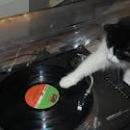¿Has probado a desactivar el turbo Aragon? No sé si tendrá la opción de apagar fases de alimentación como en las X58... Podrías mirártelo también. Te copio unas líneas de ayuda de M-Audio para temas de ruidos:
Q: I have a 60Hz hum in my audio and/or hear noise that seems to be dependent on my CPU or Harddisk activity. Why is that and what can I do about this?
A: What you are experiencing is commonly called “ground loop”. All devices in your studio should be connected to the same ground. If this is not the case and if one or more of the devices are getting their ground from somewhere else, (e.g. from a different power outlet that is running on a different electrical circuit) and devices with different ground are connected to each other (e.g mounted to the same rack rail), this type of noise might occur.
There are different ways to fix this type of problem. The easiest and most cost efficient way is what is called a “ground lift” in order to interrupt the “ground loop”. Not all devices work correctly with lifted ground and might overheat and/or create an electric shock hazard. Before lifting the ground on any device, please contact its manufacturer in order to find out if this device will work properly and if it will create an electric shock hazard under these conditions.
Depending on the amount of devices in your studio, it might be hard to find the device that is causing the problem. For this reason we suggest the following approach in order to detect the source of the problem:
1. Disconnect ALL peripheral devices from the computer except for your audio interface and speakers. Printers, network, antenna cable to a TV Tuner card, audio cables etc. should all be physically disconnected from the computer.
2. Check if the noise is still there. If not, skip to step 3 in this guide. If yes, continue with number 2a.
2a. If you are using a Laptop, unplug the power supply and run on battery power. If this resolves the problem, you will have to lift the ground on the laptop’s power supply (IMPORTANT: Contact the Laptop’s manufacturer to find out if lifting the ground is supported on this device).
2b. If you are using a Desktop computer, while you can hear the noise or have audio playing, turn your Monitor off, and then disconnect it’s power cable. If the noise is gone, you will have to lift the ground on the Monitor (IMPORTANT: Contact the Monitor’s manufacturer to find out if lifting the ground is supported on this device). If the noise is still there, reconnect your Monitor, turn it back on and go to the next step in this guide.
2c. If your audio interface has a headphone output, disconnect the powered speakers or power amp with speakers from the interface and check if the noise is audible on the headphones. If the noise is gone, you will need to lift the ground on the powered speakers or amplifier (IMPORTANT: Contact the Monitor Speakers / Power Amp’s manufacturer to find out if lifting the ground is supported on this device).
3. If disconnecting all devices resolved the noise issue, start adding one device at a time and check if the noise reoccurs. Then, lift the ground on the device that made the noise problem reoccur (IMPORTANT: Contact the manufacturer of the device you determined is causing the ground loop to find out if lifting the ground is supported on this device).
GROUND LIFT PROCEDURE:
IMPORTANT: Before you proceed, make sure that you have contacted the manufacturer of the device you intend to lift the ground on. If this is not supported for this device, lifting the ground can cause damages, serious injuries or death!
The most common ground lift procedure is to use a 3 prong to 2 prong adapter. These are available at electronic stores such as Radio Shack or Home Depot etc. Simply plug the 3 prong power cable in the adapter and the 2 prong end into the power outlet.
GROUND LOOP ISOLATORS:
Ground loop isolators provide a simple and safe way to remove ground loop noise from the audio signal. These devices work on the principle of removing the common grounding between an audio interface and the computer's power supply, ensuring that any rogue noise picked up off the power supply is not transferred into the audio signal. Most of these devices are audio ground loop isolators which require that you simply connect the ground loop isolator between your audio device's output(s) and your speakers for the isolator to safely eliminate the ground noise/hum. Another device, Hum X from Ebtech (http://www.ebtechaudio.com/humxdes.html), achieves the same effect, but instead of being inserted into the audio signal path, this device plugs in directly between the AC plug on your computer’s power supply and the AC wall outlet. The advantages of AC ground loop isolators are that they work regardless of what sort of audio connections are being used (RCA, XLR, 1/4" TS/TRS, etc.), and since they are not in the audio signal path, they should not have the potential to filter, attenuate, or otherwise color the audio signal.
Q: I have a 60Hz hum in my audio and/or hear noise that seems to be dependent on my CPU or Harddisk activity. Why is that and what can I do about this?
A: What you are experiencing is commonly called “ground loop”. All devices in your studio should be connected to the same ground. If this is not the case and if one or more of the devices are getting their ground from somewhere else, (e.g. from a different power outlet that is running on a different electrical circuit) and devices with different ground are connected to each other (e.g mounted to the same rack rail), this type of noise might occur.
There are different ways to fix this type of problem. The easiest and most cost efficient way is what is called a “ground lift” in order to interrupt the “ground loop”. Not all devices work correctly with lifted ground and might overheat and/or create an electric shock hazard. Before lifting the ground on any device, please contact its manufacturer in order to find out if this device will work properly and if it will create an electric shock hazard under these conditions.
Depending on the amount of devices in your studio, it might be hard to find the device that is causing the problem. For this reason we suggest the following approach in order to detect the source of the problem:
1. Disconnect ALL peripheral devices from the computer except for your audio interface and speakers. Printers, network, antenna cable to a TV Tuner card, audio cables etc. should all be physically disconnected from the computer.
2. Check if the noise is still there. If not, skip to step 3 in this guide. If yes, continue with number 2a.
2a. If you are using a Laptop, unplug the power supply and run on battery power. If this resolves the problem, you will have to lift the ground on the laptop’s power supply (IMPORTANT: Contact the Laptop’s manufacturer to find out if lifting the ground is supported on this device).
2b. If you are using a Desktop computer, while you can hear the noise or have audio playing, turn your Monitor off, and then disconnect it’s power cable. If the noise is gone, you will have to lift the ground on the Monitor (IMPORTANT: Contact the Monitor’s manufacturer to find out if lifting the ground is supported on this device). If the noise is still there, reconnect your Monitor, turn it back on and go to the next step in this guide.
2c. If your audio interface has a headphone output, disconnect the powered speakers or power amp with speakers from the interface and check if the noise is audible on the headphones. If the noise is gone, you will need to lift the ground on the powered speakers or amplifier (IMPORTANT: Contact the Monitor Speakers / Power Amp’s manufacturer to find out if lifting the ground is supported on this device).
3. If disconnecting all devices resolved the noise issue, start adding one device at a time and check if the noise reoccurs. Then, lift the ground on the device that made the noise problem reoccur (IMPORTANT: Contact the manufacturer of the device you determined is causing the ground loop to find out if lifting the ground is supported on this device).
GROUND LIFT PROCEDURE:
IMPORTANT: Before you proceed, make sure that you have contacted the manufacturer of the device you intend to lift the ground on. If this is not supported for this device, lifting the ground can cause damages, serious injuries or death!
The most common ground lift procedure is to use a 3 prong to 2 prong adapter. These are available at electronic stores such as Radio Shack or Home Depot etc. Simply plug the 3 prong power cable in the adapter and the 2 prong end into the power outlet.
GROUND LOOP ISOLATORS:
Ground loop isolators provide a simple and safe way to remove ground loop noise from the audio signal. These devices work on the principle of removing the common grounding between an audio interface and the computer's power supply, ensuring that any rogue noise picked up off the power supply is not transferred into the audio signal. Most of these devices are audio ground loop isolators which require that you simply connect the ground loop isolator between your audio device's output(s) and your speakers for the isolator to safely eliminate the ground noise/hum. Another device, Hum X from Ebtech (http://www.ebtechaudio.com/humxdes.html), achieves the same effect, but instead of being inserted into the audio signal path, this device plugs in directly between the AC plug on your computer’s power supply and the AC wall outlet. The advantages of AC ground loop isolators are that they work regardless of what sort of audio connections are being used (RCA, XLR, 1/4" TS/TRS, etc.), and since they are not in the audio signal path, they should not have the potential to filter, attenuate, or otherwise color the audio signal.









